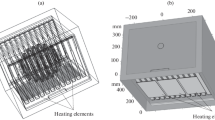Abstract
Many studies have been devoted to the passage of bees during the winter period, which indicate that this state of the bee family is yet to be understood. However, the most critical period for bees is late winter and spring. At this time, there are large temperature fluctuations in the air, and from time to time, bees are forced to switch from a passive state to an active state and vice versa. This phenomenon has mostly been observed in beekeeping apiaries in the North Caucasus regions. In the spring, positive high air temperatures provoke bees to leave the hive, and not all bees return to the hive at the end of the day. Low temperatures may lead to aggregation of bees in inconvenient places where there is neither food nor direct access to the honey reserves. This study focuses on bee behavior under these natural conditions. The main physical effects were simulated using Comsol® software. The components associated with transient processes were added to the previously developed models, which include the heat capacity of the beehive elements. The models also addressed the change in the volume of winter aggregation of bees depending on the ambient temperature. Our results suggest that the heat capacity of honey reserves has a significant effect on the temperature regime inside the hive, thus mitigating the temperature fluctuations in the spring. This is an important factor in the health of honey bees.






Similar content being viewed by others
REFERENCES
S. V. Oskin and D. A. Ovsyannikov, Biophysics (Moscow) 65 (2),331 (2020).
E. K. Eskov and V. A. Toboev, Biophysics (Moscow) 54 (1), 85 (2009).
V. A. Toboev and M. S. Tolstov, in Physical Processes in Biological Systems: Proc. All-Russia Sci. Conf. (Kazan, 2014), pp. 97–102.
V. A. Toboev and M. S. Tolstov, Nauka Obrazovanie, No. 3, 116 (2014).
S. V. Oskin and D. A. Ovsyannikov, Biophysics (Moscow) 64 (1),153 (2019).
V. A. Toboev, Pchelovodstvo, No. 1, 20 (2007).
A. I. Kas’yanov, Pchelovodstvo, No. 2, 16 (2003).
A. D. Trifonov, Pchelovodstvo, No. 11, 21 (1990).
A. F. Rybochkin and I. S. Zakharov, Computer Systems in Apiculture, 2nd ed. (Kursk. State Tech. Univ., Kursk, 2004) [in Russian].
S. V. Oskin and D. A. Ovsyannikov, Electrotechnological Techniques and Equipment for Improving Labor Efficiency in Commercial Apiculture in the Northern Caucasus (Kron, Krasnodar, 2015) [in Russian].
Author information
Authors and Affiliations
Corresponding author
Ethics declarations
CONFLICT OF INTEREST
The authors state that there is no conflict of interest.
COMPLIANCE WITH ETHICAL STANDARDS
This article does not contain any studies with the use of humans and animals as objects of research.
Additional information
Translated by A. Levina
Rights and permissions
About this article
Cite this article
Oskin, S.V., Ovsyannikov, D.A. Simulation of Spring Aggregation of Bees in Hives with Large Daily Fluctuations in Outdoor Temperature. BIOPHYSICS 65, 836–842 (2020). https://doi.org/10.1134/S0006350920050127
Received:
Revised:
Accepted:
Published:
Issue Date:
DOI: https://doi.org/10.1134/S0006350920050127




